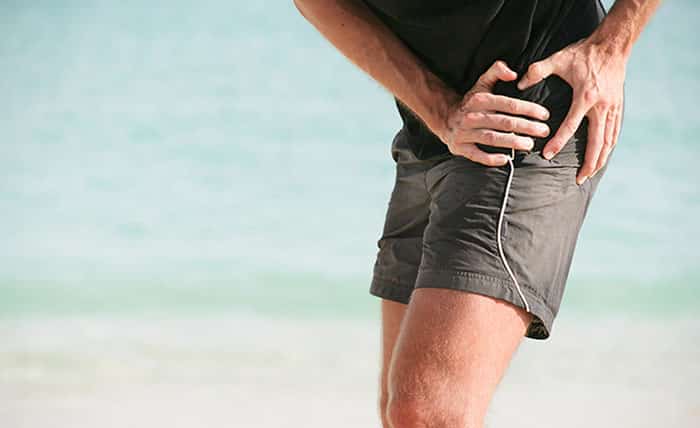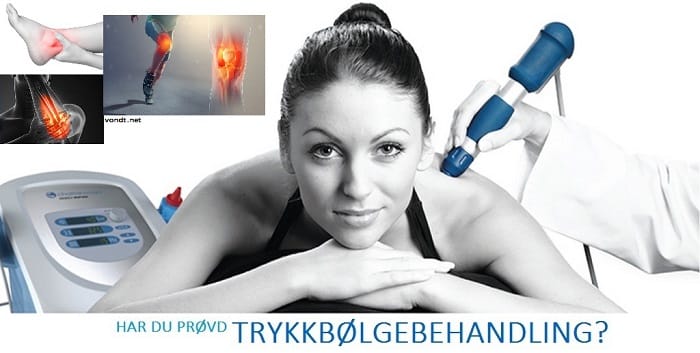
Pain in the groin
Pain in the groin and nearby structures can be bothersome and painful. Maybe you get hurt in the groin while playing football with the guys? Or have the groin pain only lasted for a long time all by itself? Like other shock-absorbing and weight-transmitting structures, groin problems can cause pain and problems in nearby anatomical structures due to compensation mechanisms and sequelae. Therefore, it is not uncommon for people to occasionally have pain in the groin, hip and back at the same time - due to the fact that they all affect each other.
Pain in the groin can be caused by several different factors, but some of the most common are muscular surges in nearby muscles, referenced pain from lower back or pelvic joints, wear, trauma, muscular malfunctions and mechanical dysfunction. Pain in the groin and groin pain is a nuisance that often afflicts athletes, but also often affects very ordinary exercisers or those who are not so happy to exercise. Such groin pain may sometimes refer to pain in the testes in men.
Watch the video of exercises for groin pain further down in the article.
VIDEO: 10 Strength Exercises Against Painful Hips And Shoulder Pain
Click here to watch a video of a groin pain training program. Strength in the hips is incredibly important when it comes to relieving the groin - in the absence of function or capacity, the groin can be overloaded.
Join our group of friends and subscribe to our YouTube channel for free exercise tips, exercise programs and health knowledge. Welcome!
- The most common cause of groin pain is muscles and joints
It is especially malfunction of the muscles and joints that provide the basis for the most common forms of pain in the groin. Rigid and dysfunctional joints in the pelvis and back are one of many possible causes that can cause the groin and hip to be overloaded during normal walking and exercise.
Painful muscles and muscle knots can be treated by a publicly authorized clinician (chiropractor, physiotherapist or manual therapist) with cutting-edge expertise in muscle, tendon, nerve and joint problems.
They are also thoroughly trained to find out why you are suffering from groin pain and what is the underlying cause. In this way, more serious diagnoses can be ruled out, reduced the chance of relapse and lower the risk of recurrence after a successful treatment program.
In this article you will learn more about why you get hurt, what you can do about it yourself and what treatment modalities are most often used to address this problem.
Contact us today via our Facebook page, the comment field in this article or via our «ASK - GET ANSWER!«Section if you have questions or need advice on the best way forward for you. Like us on Facebook for daily updates with exercises and new knowledge in musculoskeletal disorders.
Musculus iliopsoas (hip flexor) + lower back and pelvic mobility = Some of the most common functional causes of groin pain
As mentioned, there are often biomechanical reasons behind being affected by groin pain - and by this we mean muscles, tendons, nerves and joints. If one has reduced function in one or more structures then this can cause ringing effects and gradually more malfunctions and more pain will occur.
As some of the most common causes of pain in the groin - from a functional point of view - we have chosen to focus on the hip flexor (musculus iliopsoas) and impaired function in the pelvic joints, as well as the lower part of the lower back. But many of you are probably wondering where the hip flexor itself is located? Let's take a closer look at just that:
Musculus iliopsoas (on the front of the pelvis, then through the pelvis and up to the transverse ridge of the lower back vertebrae)

In more modern times, the name iliopsoas is used on the hip flexor, but before it was divided into psoas minor, psoas majus and iliacus - and not as a whole, as is done today. Iliopsoas has a pain pattern that can cause pain on the front of the upper thigh, towards the groin, as well as in the lower back (ipsilateral - on the same side).
When we see the anatomical structure of the muscle, it also becomes easier to understand that this can be affected by reduced mobility in the lumbar and pelvic joints (less range of motion in the joints) - due to incorrect movement patterns. We are therefore keen to emphasize that both joint function and muscular function are addressed in the treatment of such problems. Such a malfunction can thus also provide a basis for tight and painful buttock muscles (gluteus medius, gluteus minimus and piriformis, among others) - which in turn can lead to sciatica (false sciatica) and nerve irritation in the buttocks. It is also worth mentioning that the musculus adductor magnus has a pain pattern that can refer pain to the groin and inside of the thigh. In other words, this is something we recommend that you get help with before it develops further.
But why do the muscles on the front of the groin become painful?
Both joints and muscles contain nerve receptors - signal receivers and transmitters that are able to emit pain signals if they believe that there is a danger of long-term problems and permanent damage to tissue tissue.
Muscles consist of muscle fibers - these can be in good condition (resilient, mobile and without damage tissue) or in poor condition (less moving, with reduced healing ability and accumulation of damage tissue). When we have muscles that become defective over time, this can gradually lead to the build up of dysfunctional damage tissue in the muscular structures. By this we mean that they physically change the structure as shown in the picture below:

- Normal tissue: Normal blood circulation. Normal sensitivity in the pain fibers.
- Damage tissue: which involves reduced function, altered structure and increased pain sensitivity.
- Scar tissue: Unhealed soft tissue has a significantly reduced function, severely altered tissue structure and an increased risk of recurring problems. In phase 3, the structures and structure can be so weak that there is a higher chance of recurring problems.
Image and description - source: Råholt Chiropractor Center
It is often easier for patients to understand why muscles and tendons become painful when they see the picture above. Because it illustrates exactly how not taking care of their muscles can lead to such structural changes and thus muscle pain in the groin (or back). Conservative treatment at a publicly authorized clinician therefore aims to remodel the soft tissue structure and improve the function of given muscle fibers. The examination and the clinical examination can reveal everything from reduced mobility in the back and pelvis (which thus leads to poor shock absorption and weight transfer) to insufficient stability muscles in the hip and seat. We can hint that often (read: almost always) there is a mixture of several factors that cause you to have groin pain and that you experience that it comes back again and again.
One of the documented treatments for functional groin pain is Shockwave Therapy (Vahdatpour et al, 2013) - a treatment method performed by publicly authorized clinicians (chiropractor, physiotherapist or manual therapist) with cutting-edge expertise in the assessment and treatment of diagnoses in muscles, tendons, joints and nerves. Other treatment methods that are often used are joint treatment (performed by a chiropractor or manual therapist), intramuscular acupuncture, trigger point treatment and muscular techniques.
We think it is very illustrative to show you a thorough video where to use Shockwave Therapy against precisely groin pain due to dysfunction in the hip flexor. Pressure wave therapy thus breaks down this painful damaged tissue (which should not be there) and starts a repair process that gradually, over several treatments, replaces it with new and fresh muscle or tendon tissue. In this way, you reduce the pain sensitivity, increase the soft tissue's own healing ability and improve the muscular condition. Physical therapy should always be combined with gradual training of the hip and core muscles - with the aim of relieving the back, hip and groin through improved functional capacity.
Video - Pressure wave treatment for groin pain (click on the image to watch the video)
Source: Found.net's YouTube channel. Remember to subscribe (free) for more informative and great videos. We also welcome suggestions on what our next video will be about.
Read more: What You Should Know About Pressure Wave Therapy
Classification of pain in the groin
Groin pain is classified by dividing it by how long it has been going on. The three categories are: acute, subacute or chronic groin pain. Here is an overview of how your groin pain is categorized - and why.
Acute pain in the groin
If you have had pain in the groin for anything from one second up to three weeks, it is also called acute groin pain. Acute groin pain can often be due to groin stretch or muscle damage.
Subacute groin pain
With subacute pain in the groin, one refers to pain that has persisted for anywhere from three weeks and up to three months. If your pain has persisted for so long, we also hope that you start thinking that "now it's time for me to do something about this". Because you definitely should. Contact an authorized clinician for an assessment and possible treatment today - before it develops further and gets worse.
Chronic groin pain
When you have had pain in the groin for a full three months or longer - yes, then it is called chronic groin pain. Congratulations. Many people would not be able to lose weight for so long and go with pain for so long without tackling the problem, but you did. But do not lose all courage now - you can still do something about the problem. It is just that it will be a significantly more difficult treatment route to go now that the problem has come so far. It will require personal effort and discipline to carry out the training and treatment that is much needed.
We have previously talked about compensatory ailments - and with groin pain, this is often due to the fact that we tend to put less weight and take shorter steps on the affected side. Does that sound wise in the long run? No. Does it lead to increased pain in the hip, pelvis and back over time? Yes. It is therefore essential that you now choose to address the groin pain and say that "it's over" - even if you have been together for over three sour months, then it all just has to go. If you need a recommendation in relation to clinics, we are always available via private message on social media or in the comments field at the bottom of the relevant article.
Persistent groin discomfort? Could it be inguinal hernia?
Inguinal hernia is a condition in which part of the intestine has bulged out through the muscle wall in the groin region. The diagnosis most often involves pain during coughing and sneezing, as well as other things that increase the internal abdominal pressure. Read more about this condition here .
Clinically proven effect on the relief of pain in the groin
En Cochrane meta-study (Almeida et al, 2013) concluded that training aimed at specific hip and core muscles (eg exercises with training elastic) was among the most effective when it came to long-term effect in the treatment of sports-related groin pain. They also wrote that more and better studies in this area are needed to be able to estimate what is the best passive treatment modality. A randomized, blinded control study with 40 participants showed an effect in the treatment of groin and pelvic pain (Vahdatpour et al, 2013).
Some possible causes / diagnoses of a groin injury are:
Deep vein thrombosis (DVT)
groin Hernia (pain deep inside the groin which is worse when coughing or sneezing)
Groin stretch (stretch in the area of the muscles)
Muscle dysfunction in iliopsoas
Muscle pain from the muscle adductor magnus
Impaired joint function in the back and pelvis
Referred sciatica from lumbar prolapse (lower back prolapse)
circulation Problems
Tight groin muscles
What can I do even for groin pain?
We would especially recommend training and rehabilitation training aimed at improving and strengthening the core muscles and hip stability muscles - with the intention of, among other things, relieving the hip flexor (iliopsoas).
1. General movement, specific training and activity is recommended, but stay within the pain limit. Two walks a day of 20-40 minutes make good for the body and aching muscles.
2. Trigger point / massage balls we strongly recommend - they come in different sizes so you can hit well even on all parts of the body. There is hardly any better self-help than this. We recommend the following (click the image below) - which is a complete set of 5 trigger point / massage balls in different sizes:
3. Training: Specific training with training tricks of various opponents (such as this complete set of 6 knits of different resistance) can help you train strength and function. Knit training often involves more specific training, which in turn can lead to more effective injury prevention and pain reduction.
4. Pain Relief - Cooling: Biofreeze is a natural product that can relieve pain by cooling the area gently. Cooling is especially recommended when the pain is very severe. When they have calmed down then heat treatment is recommended - it is therefore advisable to have both cooling and heating available.
5. Pain Relief - Heating: Warming up tight muscles can increase blood circulation and reduce pain. We recommend the following reusable hot / cold gasket (click here to read more about it) - which can be used both for cooling (can be frozen) and for heating (can be heated in the microwave).
Recommended products for pain relief in pain
Biofreeze (Cold / cryotherapy)
What can I expect from a clinician when I visit them with pain in the groin?
We recommend that you seek out publicly licensed professions when seeking treatment and treatment for muscle, tendon, joint and nerve pain. These occupational groups (doctor, chiropractor, physiotherapist and manual therapist) are protected titles and approved by Norwegian health authorities. This gives you as a patient a security and safety that you will only have if you go to these professions. As mentioned, these titles are protected and this means that it is illegal to call a doctor or chiropractor without you being authorized with the long education these professions hold. In contrast, titles such as acupuncturist and naprapat are not protected titles - and this means that you as a patient do not know what you are going for.
A publicly licensed clinician has a long and thorough education that is rewarded through public health authorities with public title protection. This education is comprehensive and means that the aforementioned professions have very good expertise in investigation and diagnosis, as well as treatment and eventual training. Thus, a clinician will first diagnose your problem and then set up a treatment scheme depending on the given diagnosis. The chiropractor, physician and manual therapist have the right of referral for imaging diagnostic examination if clinically indicated.
Exercises, training and ergonomic considerations
An expert in muscle and skeletal disorders can, based on your diagnosis, inform you of the ergonomic considerations you need to take to prevent further damage, thus ensuring the fastest possible healing time. After the acute part of the pain is over, in most cases you will also be assigned home exercises that also help to reduce the chance of relapse. In the case of chronic ailments, it is necessary to go through the motor movements you do in everyday life, so as to be able to weed out the cause of your pain occurring time and again. It is important that the individual exercises are adapted to you and your ailments.
As mentioned earlier in the article, research studies have shown that hip and core training are important for relieving the groin. We therefore present several training programs in the links below that can be recommended for such training:
- Here you will find an overview and list of exercises we have published in connection with counteracting, prevention and relief of groin pain, groin pain, tight groin muscles and other relevant diagnoses.
Overview - Exercise and exercises for pain in the groin and groin pain:
6 Strength Exercises for Stronger Hips
Are you plagued with long-term and chronic pain?
We recommend to anyone who is suffering from chronic pain in everyday life to join the Facebook group “Rheumatism and Chronic Pain - Norway: Research and News". Here you can get good advice and ask questions to like-minded and those with expertise in the area. You can also follow and like our Facebook page (Vondt.net) for daily updates, exercises and new knowledge in muscle and skeletal disorders.
NEXT PAGE: - What is Pressure Wave Treatment?
Click on the image above to move on to the next article.
Also read:
References:
- NHI - Norwegian Health Informatics
- Almeida et al. Conservative interventions for treating exercise-related muscular tendinous, ligamentous and osseous groin pain. Cochrane Database System Rev. 2013 Jun 6; 6: CD009565.
Vahdatpour et al, 2013. Efficacy of Extracorporeal Shock Wave Therapy for the Treatment of Chronic Pelvic Pain Syndrome: A Randomized, Controlled Trial.
Frequently Asked Questions:
Gets hurt in right groin when running on asphalt. What could it be?
Pain in the right groin when running on asphalt or hard ground may be due to overload, malfunction or an underlying injury. The most common source of pain against the groin is one combination of joint restrictions in the lower back, pelvis and hip, combined with muscle tension / myoses in the seat (eg. gluteus medius myalgia) and lower back (quadratus lumborum can hurt the groin). If you have cough / sneezing pain, there may also be an underlying sports hernia in the area, although this is more rare than the other causes. More rarely, pelvic or spinal nerve irritation can also cause pain to the groin.
To prevent groin pain when running, you should increase your training against pelvic stability, core muscles and hip muscles. For example, try these exercises we have made for you here . You should also evaluate your footwear, as this may not be enough for you cushioning. But most important of all - run on rough terrain, preferably forests and fields. Get away from the asphalt jungle.
Similar questions with the same answer: 'Why do I have pain in the right side of the groin?', 'Why am I numb in the pelvis and groin after running? Does this often happen in men? ',' Experiencing groin discomfort when running - what are these symptoms of? '
Has acute groin pain after a jog. What could have gone wrong inside the groin?
Sudden / acute groin pain may occur, for example, due to hamstring (muscle strain in the groin) or inguinal hernia. The pain is usually due to overload of muscles or joints - and the pain you feel in the groin can also be referred from the hip on the same side. Especially running on hard surfaces tends to cause this type of acute groin pain.
Similar questions with the same answer: 'What can cause sudden groin pain after jogging?'
Have groin pain in the left side after jogging? What might be the diagnosis of such groin pain?
A similar question has been asked before and we ask you to read the answer to that question in addition to this. Based on the little information you give us, there can be a number of diagnoses that give you pain in the left side of the groin, but since it happened after running - we take the chance to say that it is probably a strain injury due to incorrect loading or overload. myalgias in the hips, pelvis, thighs and groin can all cause pain after a hard workout. In fact, groin pain is often caused by dysfunction in the pelvis or hip - which means that these do not work as shock-relieving as they should. Did you know that the hip is one of the most important shock absorbers we have? If it cannot do its job, the forces / loads will often hit the lower back, pelvis and groin. Other possible diagnoses are hernia, iliopsoas bursitis or hip fatigue.
Related questions with the same answer: 'Has pain in the left groin after jogging. What diagnosis can it be? ',' Why do I have pain in the left side of the groin after running? '
Has groin pain when coughing. What is the diagnosis?
Coughing and sneezing are both examples of things that increase the internal abdominal pressure / abdominal pressure - for example in a hernia (read: inguinal hernia) such a pressure change can cause pain in the damaged, irritated area. A clinician will also feel an enlargement / swelling of the host over the hernia when hosting. In the groin we also find large lymph nodes that may be infected or infected inflammation.
What are the symptoms of inflamed groin?
Typical symptoms of inflammation are reddish and irritated skin, swelling and heat development. A diagnosis that must be ruled out by swelling of the groin is hernia.
Constantly heard of women getting groin pain. Does groin pain affect men and women equally?
If you are aiming for inguinal hernia, this is a direct error - inguinal hernia most often affects men (10 times more often than women) and usually occurs after the age of 40. This is because men have a significantly weaker abdominal wall in the affected area. On the other hand, there is a higher incidence of referred pain from the pelvis, hip and buttocks among women - and this can contribute to groin pain.










Struggling with pain in the groin band from the side of the symphysis all the way up to the iliac crest and further up deep in the abdomen on the same side. Is also so tender on the outside of the hip that it is impossible to lie on that side. Has been a few months, I stretch on the roller, trigger ball and am still just as sore and impossible to sleep. Do you have tips for self-help?